CITROEN DS3 2018 Handbook (in English)
Manufacturer: CITROEN, Model Year: 2018, Model line: DS3, Model: CITROEN DS3 2018Pages: 248, PDF Size: 8.79 MB
Page 1 of 248
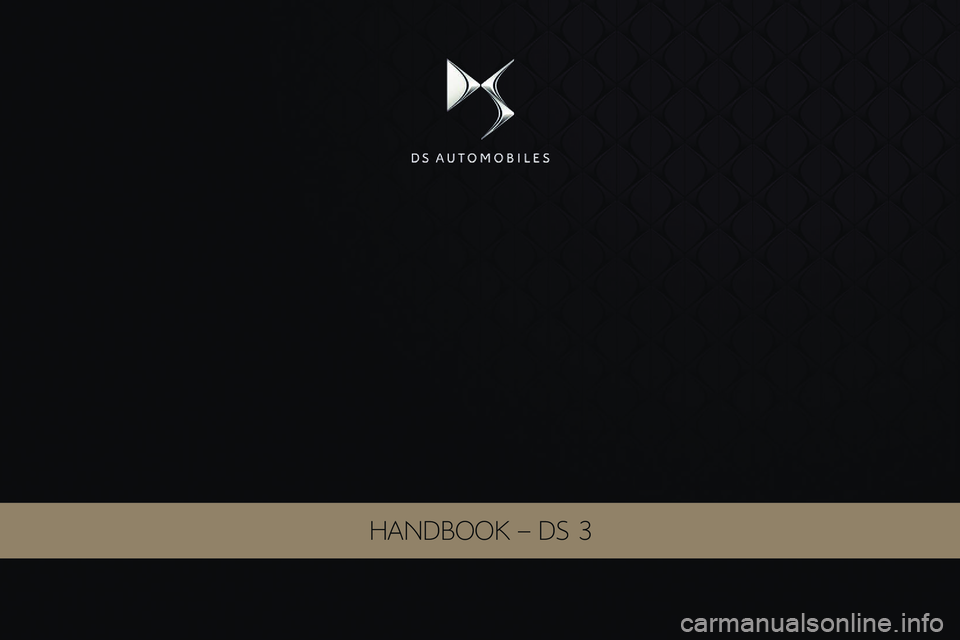
HANDBOOK – DS 3
Page 2 of 248

Access to the Handbook
The Handbook is available on the DS AUTOMOBILES
website, in the "MyDS" section or at the following
address:
http://service.dsautomobiles.com
This symbol indicates the latest information
available.
Select:
-
t
he language,
-
t
he vehicle, its body style,
-
t
he print edition of your handbook corresponding to the date
of 1
st registration of your vehicle.
Direct access to the Handbook .
Then select:
-
t
he vehicle,
-
t
he print edition corresponding to the date of 1
st registration of your
vehicle.
Download the content of the vehicle's Handbook .
From the appropriate Store, download the Scan MyDS
application for smartphone.
Page 3 of 248
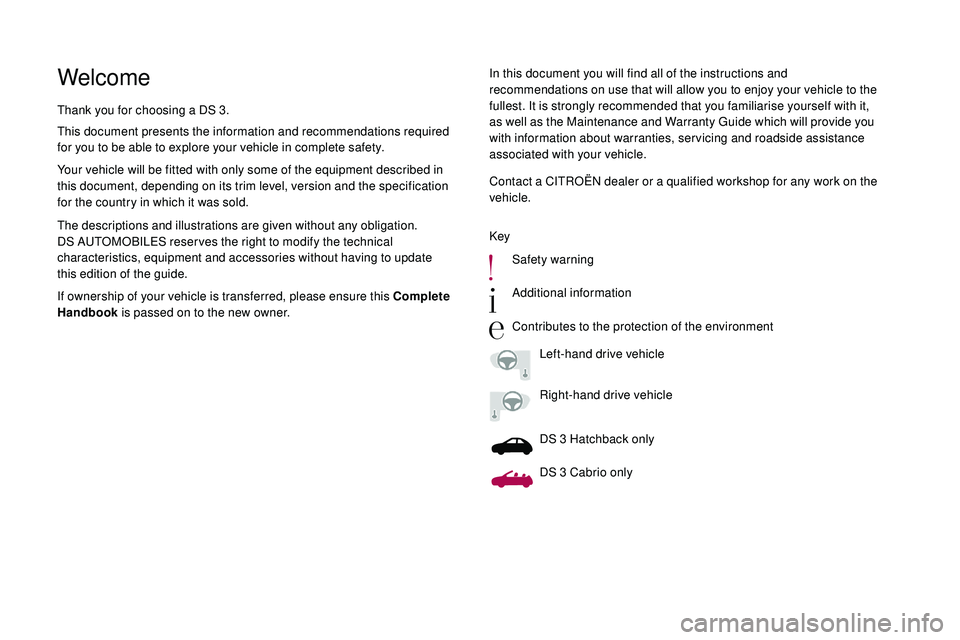
WelcomeIn this document you will find all of the instructions and
recommendations on use that will allow you to enjoy your vehicle to the
fullest. It is strongly recommended that you familiarise yourself with it,
as well as the Maintenance and Warranty Guide which will provide you
with information about warranties, servicing and roadside assistance
associated with your vehicle.
Thank you for choosing a
DS 3.
This document presents the information and recommendations required
for you to be able to explore your vehicle in complete safety.
Your vehicle will be fitted with only some of the equipment described in
this document, depending on its trim level, version and the specification
for the country in which it was sold.
The descriptions and illustrations are given without any obligation.
DS
AUTOMOBILES reser ves the right to modify the technical
characteristics, equipment and accessories without having to update
this edition of the guide.
If ownership of your vehicle is transferred, please ensure this Complete
Handbook is passed on to the new owner. Contact a
CITROËN dealer or a qualified workshop for any work on the
vehicle.
Key
Safety warning
Additional information
Contributes to the protection of the environment
Left-hand drive vehicle
Right-hand drive vehicle
DS 3
Hatchback only
DS 3
Cabrio only
Page 4 of 248
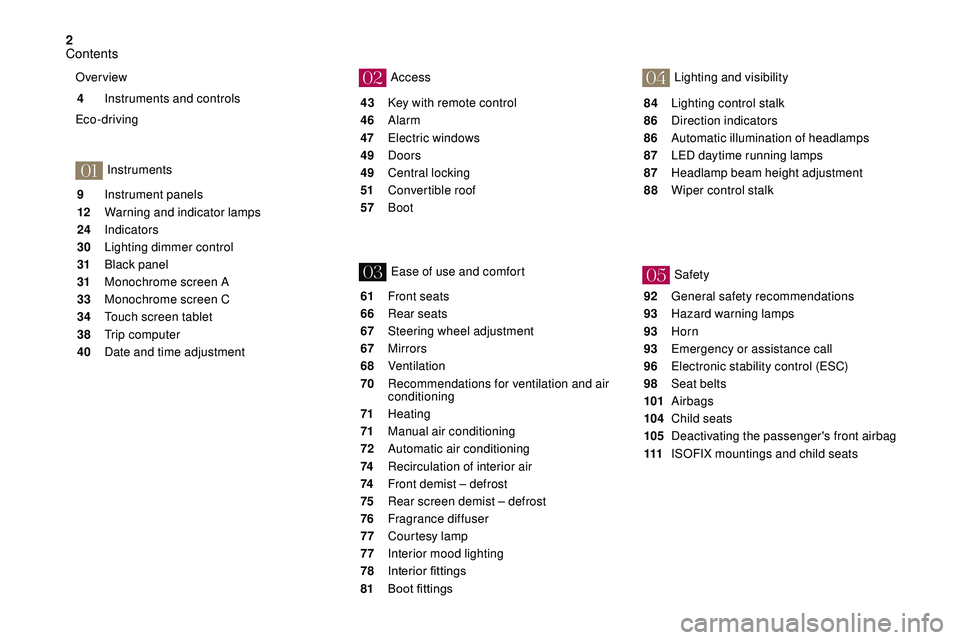
2
01
02
03
04
05
9 Instrument panels
12
W
arning and indicator lamps
24
Indicators
30
L
ighting dimmer control
31
B
lack panel
31
M
onochrome screen A
33
M
onochrome screen C
34
T
ouch screen tablet
38
T
rip computer
40
D
ate and time adjustment
4
I
nstruments and controls
43
K
ey with remote control
46
Alarm
47
E
lectric windows
49
D
oors
49
C
entral locking
51 C onvertible roof
57 Boot
61
F
ront seats
66
R
ear seats
67
S
teering wheel adjustment
67
Mirrors
68
V
entilation
70
R
ecommendations for ventilation and air
conditioning
71
H
eating
71
M
anual air conditioning
72
A
utomatic air conditioning
74
R
ecirculation of interior air
74
F
ront demist – defrost
75
R
ear screen demist – defrost
76
F
ragrance diffuser
77
C
ourtesy lamp
77
I
nterior mood lighting
78 Interior
fi
ttings
81 Boot
fittings84
L
ighting control stalk
86
D
irection indicators
86
A
utomatic illumination of headlamps
87
LE
D daytime running lamps
87
H
eadlamp beam height adjustment
88 W iper control stalk
92
G
eneral safety recommendations
93
H
azard warning lamps
93
H
orn
93
E
mergency or assistance call
96
E
lectronic stability control (ESC)
98
Se
at belts
101
Airbags
104
Ch
ild seats
105
D
eactivating the passenger's front airbag
111
I
SOFIX mountings and child seats
Over view
Instruments Access
Ease of use and comfort Safety Lighting and visibility
Eco-driving
Contents
Page 5 of 248
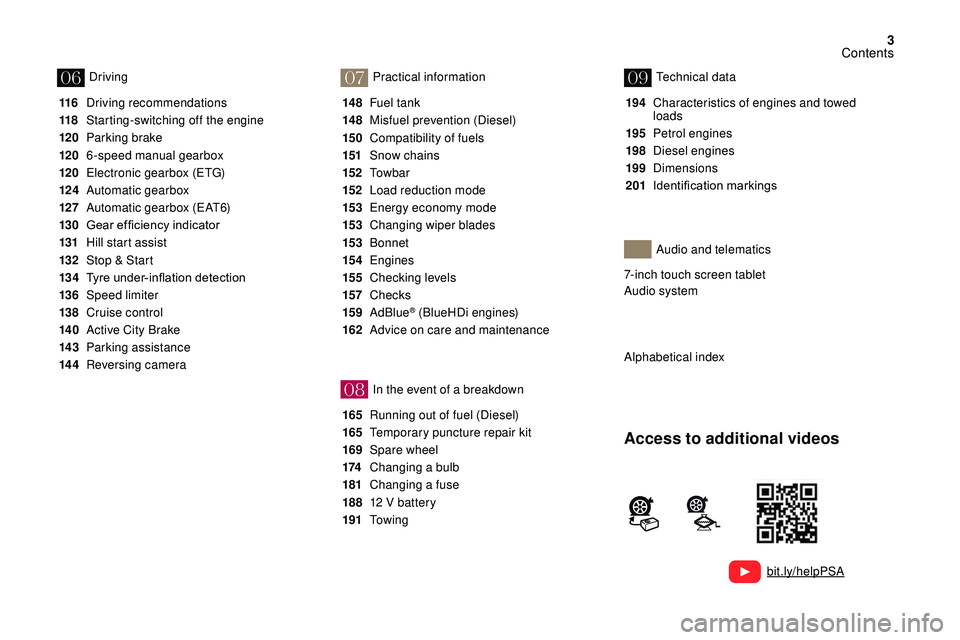
3
07
08
0609
bit.ly/helpPSA
116 Driving recommendations
118
S
tarting-switching off the engine
120
P
arking brake
120
6
-speed manual gearbox
120
E
lectronic gearbox (ETG)
124
Aut
omatic gearbox
127
A
utomatic gearbox (EAT6)
130 Gear
ef ficiency indicator
131
H
ill start assist
132
St
op & Start
13 4 Tyre
under-inflation detection
136
Spe
ed limiter
138
C
ruise control
14 0
A
ctive City Brake
14 3
P
arking assistance
14 4
R
eversing camera 14 8 Fu
el tank
14 8
M
isfuel prevention (Diesel)
15 0
C
ompatibility of fuels
151
S
now chains
152
To w b a r
152
L
oad reduction mode
15 3
E
nergy economy mode
15 3
C
hanging wiper blades
15 3
Bonnet
15 4
Engines
155
Ch
ecking levels
157
C
hecks
15 9
Ad
Blue
® (BlueHDi engines)
162
A
dvice on care and maintenance
165
R
unning out of fuel (Diesel)
165
T
emporary puncture repair kit
169
S
pare wheel
174
C
hanging a
bulb
181
C
hanging a
fuse
188
1
2
V battery
191
To w i n g 194
C
haracteristics of engines and towed
loads
195
Pe
trol engines
198
D
iesel engines
199
Dimensions
201 Identification
ma
rkings
Driving
Practical information
In the event of a
breakdown Technical data
Alphabetical index Audio and telematics
Access to additional videos
7-inch touch screen tablet
Audio system
Contents
Page 6 of 248
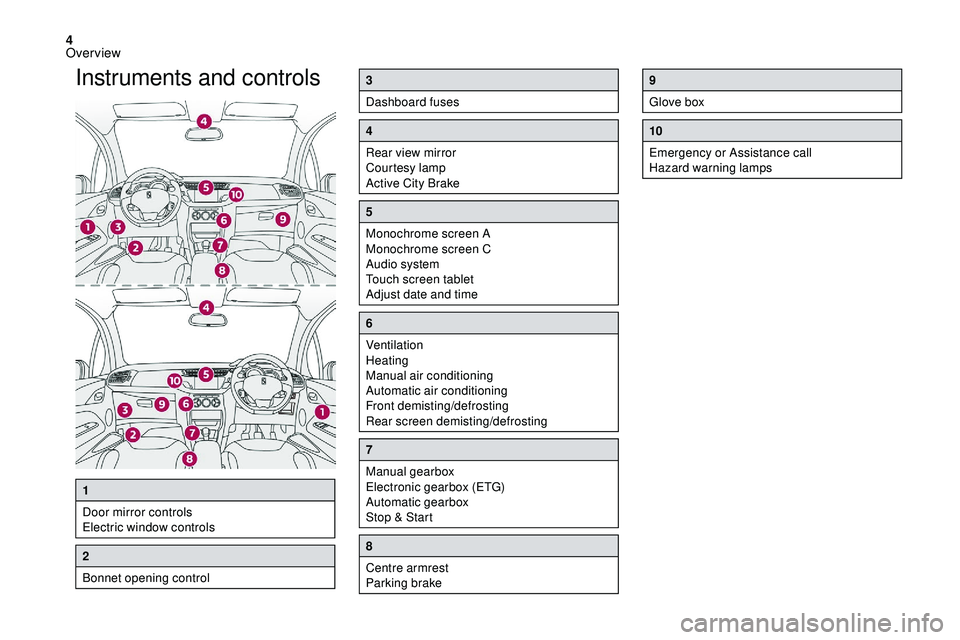
4
Instruments and controls3
Dashboard fuses
4
Rear view mirror
Courtesy lamp
Active City Brake
5
Monochrome screen A
Monochrome screen C
Audio system
Touch screen tablet
Adjust date and time
6
Ventilation
Heating
Manual air conditioning
Automatic air conditioning
Front demisting/defrosting
Rear screen demisting/defrosting
7
Manual gearbox
Electronic gearbox (ETG)
Automatic gearbox
Stop & Start
8
Centre armrest
Parking brake
9
Glove box
10
Emergency or Assistance call
Hazard warning lamps
1
Door mirror controls
Electric window controls
2
Bonnet opening control
Over view
Page 7 of 248
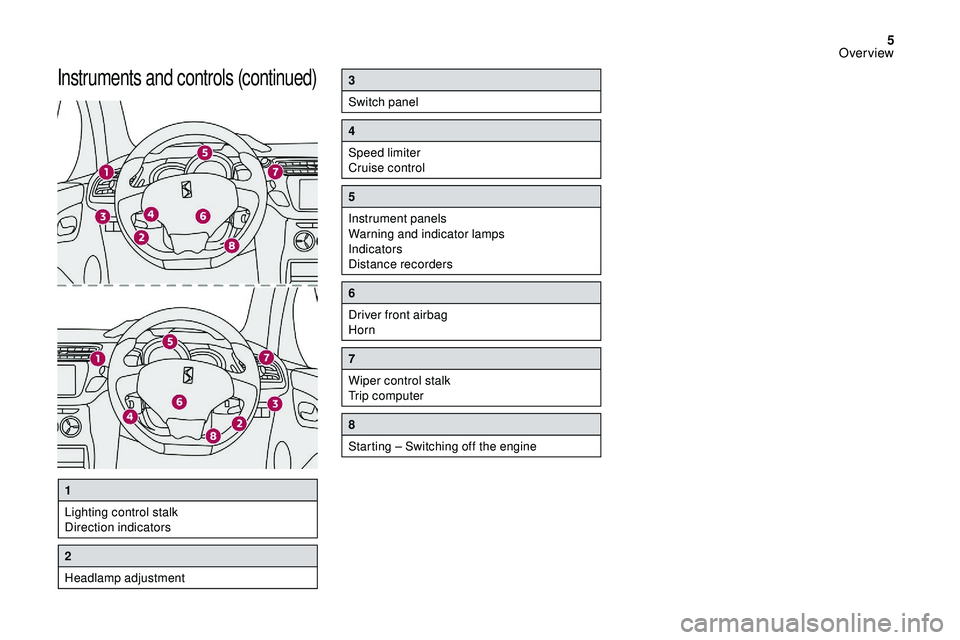
5
Instruments and controls (continued)3
Switch panel
4
Speed limiter
Cruise control
5
Instrument panels
Warning and indicator lamps
Indicators
Distance recorders
6
Driver front airbag
Horn
7
Wiper control stalk
Trip computer
8
Starting – Switching off the engine
1
Lighting control stalk
Direction indicators
2
Headlamp adjustment
Over view
Page 8 of 248

6
Eco-driving
Eco-driving is a range of everyday practices
t hat allow the motorist to optimise their fuel
consumption and CO
2 emissions.
Optimise the use of your gearbox
With a manual gearbox, move off gently
an d change up without waiting. During
acceleration, change up early.
With an automatic gearbox, give preference
to automatic mode and avoid pressing the
accelerator pedal heavily or suddenly.
The gear efficiency indicator invites you to
engage the most suitable gear: as soon as the
indication is displayed in the instrument panel,
follow it straight away.
For vehicles fitted with an automatic gearbox,
this indicator appears only in manual mode.
Drive smoothly
Maintain a safe distance between vehicles,
u se engine braking rather than the
brake pedal, and press the accelerator
progressively. These practices contribute
towards a
reduction in fuel consumption and
CO
2 emissions and also help reduce the
b
ackground traffic noise.
If your vehicle has cruise control, make use of
the system at speeds above 25
mph (40 km/h)
when the traffic is flowing well.
Control the use of your electrical
equipment
Switch off the demisting and defrosting
controls, if these are not automatically
managed.
Switch off the heated seat as soon as
possible.
Switch off the headlamps and front foglamps
when the ambient light level does not require
their use.
Avoid running the engine before moving off,
particularly in winter; your vehicle will warm up
much faster while driving.
Before moving off, if the passenger
compartment is too warm, ventilate it by
opening the windows and air vents before
using the air conditioning.
Above 30
mph (50
km/h), close the windows
and leave the air vents open.
Consider using equipment that can help
keep the temperature in the passenger
compartment down (sunroof blind and window
blinds, etc.).
Unless it has automatic regulation, switch off
the air conditioning as soon as the desired
temperature has been reached. As a
passenger, if you avoid connecting your
multimedia devices (film, music, video game,
etc.), you will contribute towards limiting the
consumption of electrical energy, and so of
fuel.
Disconnect your portable devices before
leaving the vehicle.
Eco-driving
Page 9 of 248

7
Limit the causes of excess
consumption
At the end of winter, remove snow tyres and
refit your summer tyres.
Observe the recommendations on
maintenance
Check the tyre pressures regularly, when cold,
referring to the label in the door aperture,
driver's side.
Carry out this check in particular:
-
b
efore a long journey,
-
a
t each change of season,
-
a
fter a long period out of use. Have your vehicle ser viced regularly (engine
oil, oil filter, air filter, cabin filter, etc.) and
obser ve the schedule of operations in the
manufacturer's service schedule.
With a
BlueHDi Diesel engine, if the SCR
system is faulty, your vehicle becomes
polluting. As soon as possible, visit a member
of the dealer network or a qualified workshop
to make your vehicle's level of nitrogen oxides
emissions compliant to the standard.
When filling the tank, do not continue after the
3
rd cut-off of the nozzle to avoid over flow.
At the wheel of your new vehicle, it is only
after the first 1,900
miles (3,000 kilometres)
that you will see the fuel consumption settle
down to a
consistent average.
Spread loads throughout the vehicle; place
the heaviest items in the bottom of the boot,
as close as possible to the rear seats.
Limit the loads carried in the vehicle and
reduce wind resistance (roof bars, roof rack,
bicycle carrier, trailer, etc.). Preferably, use a
roof box.
Remove roof bars and roof racks after use.
Do not forget the spare wheel and the tyres on
any trailer or caravan.
Eco-driving
Page 10 of 248
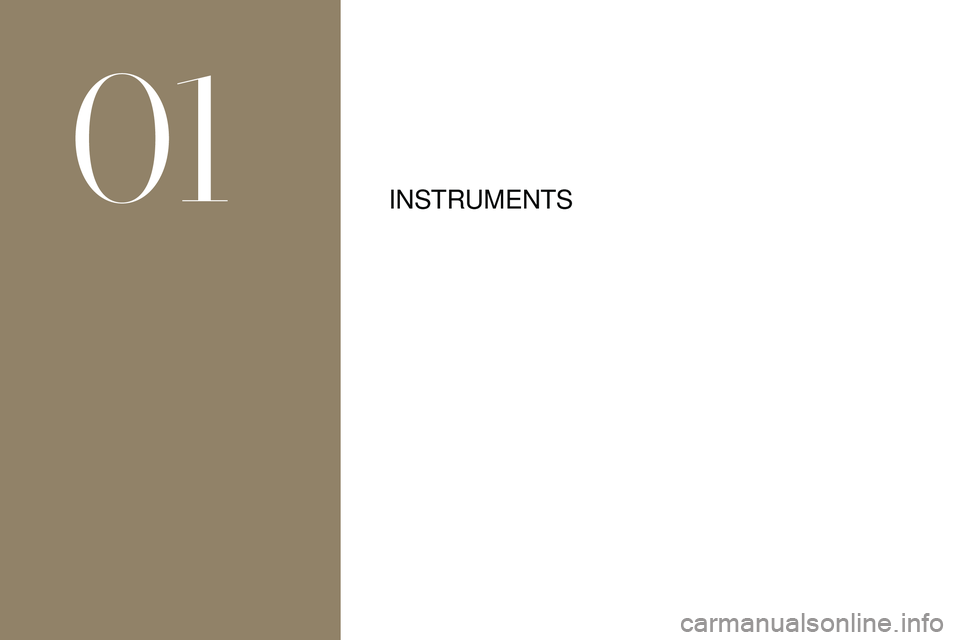
INSTRUMENTS
01